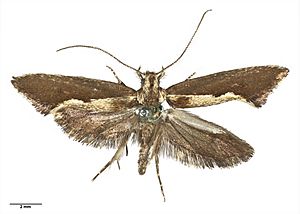Tinea belonota facts for kids
Quick facts for kids Tinea belonota |
|
|---|---|
 |
|
| Scientific classification | |
| Kingdom: | |
| Phylum: | |
| Class: | |
| Order: | |
| Family: | |
| Genus: |
Tinea
|
| Species: |
T. belonota
|
| Binomial name | |
| Tinea belonota Meyrick, 1888
|
|
| Synonyms | |
|
|
Tinea belonota is a small moth that belongs to a group called Tineidae. This moth is special because it is found only in New Zealand. It is currently considered "not threatened" by New Zealand's Department of Conservation, which means it's not in danger of disappearing.
Contents
What is Tinea belonota?
Naming the Moth
Scientists give every living thing a special two-part name. This helps everyone know exactly which plant or animal they are talking about. The moth Tinea belonota was first described by a scientist named Edward Meyrick in 1888. He studied a moth found in Palmerston North, New Zealand.
Later, in 1926, another scientist, Charles E. Clarke, thought he had found a new type of moth. He named it Gymnobathra zephyrana. However, in 1931, a scientist named Alfred Philpott realized that Gymnobathra zephyrana was actually the same moth as Tinea belonota. So, the older name, Tinea belonota, was kept.
What Does it Look Like?
Tinea belonota is a small moth, about 13 millimeters (half an inch) long. Its head is a light brownish-white color. The rest of its body, including its antennae and legs, is mostly dark brown.
Its front wings are a dark brownish color. They have a special light, yellowish-white stripe along the bottom edge. This stripe has a few small bumps or projections on it. There's also a tiny dark spot on the stripe. The back wings are also dark brown but are a bit lighter and thinner near the body.
This moth looks a bit like two other moths, Trithamnora certella and Tinea mochlota. But Tinea belonota has wider wings and a clearer light stripe. It also doesn't have certain spots that the other moths do.
Where Does Tinea belonota Live?
This moth is found only in New Zealand. This means it is endemic to New Zealand. Scientists have found Tinea belonota in a few places. These include Palmerston North, Whangarei, and a place called Okauia in the Waikato region.
How is Tinea belonota Doing?
The New Zealand Threat Classification System helps keep track of how many plants and animals are left. This system has classified Tinea belonota as "not threatened." This is good news! It means that for now, there are enough of these moths, and they are not in danger of disappearing.

